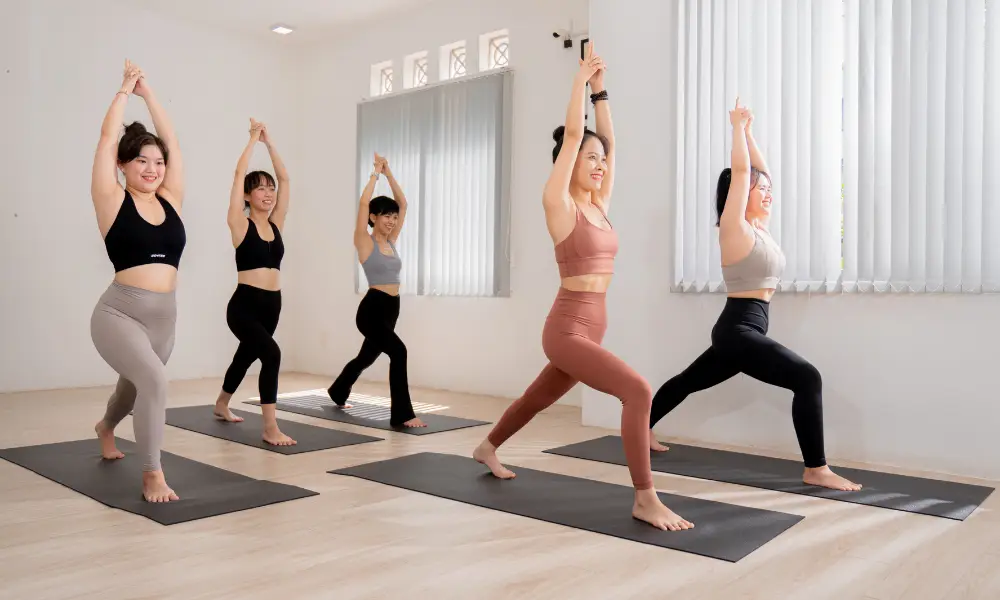Hatha yoga is the most popular form of yoga practiced in the United States. This is a branch of yoga that specifically focuses on physical and mental health. Hatha yoga uses postures (asanas), breathing techniques (pranayama) and meditation (dyana), with the goal of bringing about a healthy body and a peaceful, peaceful soul.
There are nearly 200 hatha yoga poses with hundreds of different variations, to help keep the spine supple and promote circulation between organs and tissue glands. Hatha yoga posture also helps stretch the body, keeping the body balanced and flexible.
In this article, we will delve deeper into the definition of Hatha Yoga, its origins, development, and benefits of this particular yoga practice. The content of the article is shared by Linh, a member of LotusBuddhas who has been practicing Yoga for over 3 years.
What is Hatha Yoga?

Hatha Yoga is often considered the foundation of all yoga styles, a kind of umbrella under which various physical practices of yoga sit. “Hatha” combines two Sanskrit words: “Ha,” meaning sun, and “Tha,” meaning moon, symbolizing the balance of opposites. This form of yoga aims to harmonize the active and receptive qualities within us, balancing effort and surrender in each pose.
In a typical Hatha Yoga class, you’ll engage in a series of physical postures (asanas) and breathing techniques (pranayama), performed more slowly and with more static posture holds than something like Vinyasa or Ashtanga yoga. This slower pace is ideal for beginners because it allows ample time to learn and internalize each posture’s alignment and benefits. Yet, don’t be fooled into thinking it’s easy; holding poses can be quite a challenge and offers deep strengthening and stretching.
Hatha Yoga is not just physical exercise, though. It’s a holistic practice that integrates physical postures, mental concentration, and focused breathing to develop strength, flexibility, body awareness, and mental clarity. Through its practice, you can cultivate a sense of inner peace and calm, learn to manage stress better, and explore deeper aspects of your mind and consciousness.
Beyond the mat, Hatha Yoga encourages practitioners to carry the balance and harmony they cultivate during practice into their daily lives. It promotes a lifestyle of health and mindfulness, encouraging habits that support physical, mental, and spiritual well-being.
History of Hatha Yoga

Hatha Yoga has a rich and nuanced history spanning centuries, deeply rooted in the Indian yoga tradition. Its origins are often traced back to early Hindu scriptures, including the Upanishads and Bhagavad Gita, where the concept of yoga as a spiritual and ascetic discipline first emerged. However, Hatha Yoga as we know it today began to crystallize in the medieval period, especially between the 9th and 15th centuries CE.
The foundational text of Hatha Yoga is the Hatha Yoga Pradipika, written by Swami Swatmarama in the 15th century. This text, along with others such as the Gheranda Samhita and Shiva Samhita, outlines the techniques and philosophy of Hatha Yoga, includes asanas (poses), pranayama (breathing techniques), mudras (gestures) and meditation. These texts emphasize not only physical health but also spiritual enlightenment, aiming to balance and integrate the physical and subtle energies of the body.
Historically, Hatha Yoga was practiced by ascetics and yogis who sought to overcome physical limitations and achieve spiritual liberation (moksha). They use their bodies as tools to refine their control over their minds and energies, a process they believe will lead to enlightenment.
In the 20th century, Hatha Yoga began to spread beyond India, thanks in part to pioneering teachers who traveled to the West. Figures like Swami Sivananda, B.K.S. Iyengar, T.K.V. Desikachar and Pattabhi Jois played important roles in popularizing yoga worldwide, each contributing their own interpretations and methods. As a result, Hatha Yoga has evolved into many different styles and schools, each emphasizing different aspects of the practice but all rooted in the same basic principles.
Today, Hatha Yoga is practiced globally, beloved for its ability to improve physical health, reduce stress and provide spiritual insights. It has been adapted in countless ways to suit modern lifestyles and preferences, yet its core goal remains the same: to balance and harmonize the body, mind and spirit, bringing out the best in you. The path to peace and happiness is as relevant as it is today. many centuries ago.
8 Principles of Hatha Yoga

Hatha Yoga principles encompass a wide range of techniques and philosophies, allowing practitioners to develop a deeper understanding of the human body, mind, and spirit. Some of the core principles of Hatha Yoga include:
1. Balancing opposing forces: Hatha Yoga aims to create harmony between the sun (ha) and moon (tha) energies within the body, representing the active and passive aspects of our being. By cultivating a balance between these opposing forces, practitioners can achieve inner equilibrium and experience greater mental and emotional stability.
2. Asanas (postures): Asanas form the foundation of Hatha Yoga practice, with each posture targeting specific muscle groups, joints, and organs. These postures not only improve physical strength, flexibility, and balance but also work on a subtle level, influencing the body’s energy channels (nadis) and chakras (energy centers).
3. Pranayama (breath control): Pranayama is a critical component of Hatha Yoga, as it helps regulate the flow of prana (vital life force) within the body. By consciously controlling the breath, practitioners can enhance mental focus, calm the mind, and increase overall energy levels.
4. Meditation and mindfulness: Hatha Yoga emphasizes the importance of meditation and mindfulness in cultivating self-awareness and fostering a deeper connection to one’s inner self. Through regular meditation, individuals can achieve mental clarity, emotional balance and spiritual growth.
5. Ethical principles: Hatha Yoga practitioners are encouraged to adhere to the Yamas and Niyamas, ethical guidelines that promote moral conduct and personal discipline. These principles, which include non-violence, truthfulness, non-stealing, and contentment, serve as a foundation for cultivating a balanced and meaningful life.
6. Purification and detoxification: Hatha Yoga incorporates various cleansing techniques (Shatkarmas) that help detoxify the body and purify the mind. These practices can include nasal cleansing (jala neti), digestive cleansing (shankhaprakshalana), and eye cleansing (trataka), among others.
7. Mudras (gestures) and Bandhas (energy locks): Mudras and Bandhas are advanced Hatha Yoga techniques that help channel and direct the flow of energy within the body. By engaging specific gestures and locks, practitioners can enhance their concentration, stimulate the flow of prana, and deepen their meditation practice.
8. Self-realization: The ultimate goal of Hatha Yoga is to achieve self-realization, a state of inner awareness and unity with the true self. Through the diligent practice of asanas, pranayama, meditation, and adherence to ethical principles, Hatha Yoga practitioners can gradually dissolve the illusion of separateness and experience the interconnectedness of all existence.
Benefits of Practicing Hatha Yoga

Practicing Hatha Yoga offers a myriad of benefits that ripple through every aspect of your life, touching the physical, mental, and emotional realms. Here’s how dedicating time to Hatha Yoga can enhance your well-being:
Improves Flexibility
Regularly stretching through the various asanas gently lengthens your muscles and increases your range of motion. Over time, you might notice the ease in bending, reaching, and twisting, activities that may have seemed challenging before.
Builds Strength
While Hatha Yoga is often perceived as gentle, it requires and builds significant strength. Holding poses, especially when done for several breaths, can be quite a workout for your muscles, reinforcing core, arm, leg, and back strength.
Promotes Relaxation and Reduces Stress
The mindful breathing and focused attention of Hatha Yoga encourage a state of mental relaxation. This can help reduce stress, lower your blood pressure, and improve sleep, offering a natural counterbalance to life’s hustles and bustles.
Enhances Mental Focus and Concentration
The practice demands a level of concentration and mental engagement that can sharpen your focus. Over time, this aspect of Hatha Yoga can improve your ability to concentrate in other areas of life as well.
Encourages Mind-Body Connection
Hatha Yoga invites you to tune into your body, notice its sensations, and respect its limits. This fosters a deeper connection with your physical self, promoting a sense of presence that can be profoundly grounding.
Supports Emotional Equilibrium
By balancing physical exertion with relaxation and meditation, Hatha Yoga can help level out emotional highs and lows. Many find that regular practice cultivates a more stable and positive mood.
Offers a Path for Spiritual Exploration
While not everyone approaches yoga with spirituality in mind, many find that their practice becomes a journey into their inner selves. Hatha Yoga, with its emphasis on balance and mindfulness, provides fertile ground for such exploration.
Improves Breathing
The pranayama (breathing exercises) in Hatha Yoga teach you to control your breath, which can enhance lung function, boost oxygen levels to your brain and body, and even help manage conditions like asthma.
Some Basic Hatha Yoga Poses for Beginners and How to Do It
Absolutely, diving into Hatha Yoga as a beginner is an exciting journey, and starting with some basic poses can set a solid foundation. Here are a few fundamental Hatha Yoga poses that are great for beginners, along with guidance on how to do them:
- Mountain Pose (Tadasana): This foundational standing pose helps you learn how to ground in your feet and feel the earth beneath you. Stand with your feet together, press down through all ten toes, lift your chest, and engage your core. Let your arms rest at your sides, palms facing forward, and gaze forward. This pose teaches balance and improves posture.
- Downward-Facing Dog (Adho Mukha Svanasana): Start on your hands and knees, tuck your toes, lift your hips, and straighten your legs. Spread your fingers wide and press through your palms. This pose strengthens the arms and legs, stretches the shoulders, hamstrings, and calves, and can help relieve back pain.
- Warrior II (Virabhadrasana II): From a standing position, step one foot back and open your hips to the side. Extend your arms out to the sides and bend your front knee, ensuring it’s directly over your ankle. Gaze over your front hand. This pose strengthens the legs, opens the hips and chest, and builds concentration.
- Tree Pose (Vrksasana): Start in Mountain Pose, then shift your weight onto one leg. Place the sole of your other foot on your inner thigh or calf (just not on the knee) and press your hands together in prayer position at your heart center. This pose improves balance, focus, and the alignment of your body.
- Seated Forward Bend (Paschimottanasana): Sit with your legs extended in front of you, inhale and lengthen your spine, then exhale as you fold forward from the hips over your legs. This pose stretches the spine and hamstrings and calms the mind.
- Cobra Pose (Bhujangasana): Lie on your stomach with your hands under your shoulders and elbows close to your body. Press into your hands and lift your chest off the ground, keeping your elbows slightly bent. This pose strengthens the spine, opens the chest and shoulders, and stimulates abdominal organs.
- Corpse Pose (Savasana): Lie flat on your back, arms at your sides with palms facing up, and let your feet fall open. Close your eyes and breathe deeply, allowing your body to relax and integrate the benefits of your practice. This pose is essential for concluding your practice, allowing for relaxation and rejuvenation.
You must remember, yoga is about connecting with your body and breath, so move gently into each pose, respect your body’s limits, and breathe deeply. These poses provide a great starting point for your Hatha Yoga journey, building strength, flexibility, and mindfulness that you can carry into more advanced practices or simply enjoy as a foundational routine.
Notes When Practicing Hatha Yoga
When practicing Hatha Yoga, it’s crucial to perform each pose correctly and at a suitable pace to prevent injuries. This is especially important for beginners. Here’s some advice to help you practice safely and effectively:
- Seek Proper Guidance: If you’re new to yoga, it’s wise to learn under the guidance of a qualified yoga instructor. They can provide personalized feedback and adjustments to ensure you’re performing each pose correctly.
- Listen to Your Body: When trying a new pose at home, if something feels off or even painful, you might be doing it incorrectly. If this happens, stop immediately to avoid injury and take time to review the pose. It’s always better to learn the correct form from a professional, either in person or through reputable online resources.
- Progress Gradually: Don’t rush your progress. Hatha Yoga is not about achieving the most advanced poses but about finding balance and harmony within your body. Advance to more complex poses only when you feel ready and comfortable.
- Create a Safe Practice Space: Ensure your practice area is clear and spacious enough to move freely. Use a good-quality yoga mat to provide adequate cushioning and prevent slipping.
- Consistent Practice: Regular practice is key to reaping the full benefits of Hatha Yoga. Even short, daily sessions can significantly impact your stress levels, sleep quality, and overall well-being.
- Mindfulness: Pay attention to your breath and the sensations in your body as you practice. This mindfulness aspect is central to yoga, helping to integrate the physical and mental benefits of your practice.
In summary, understanding and integrating the principles of Hatha Yoga into your daily routine can offer profound benefits for your mind and body. From reducing stress and anxiety to improving sleep and managing chronic pain, Hatha Yoga is an excellent form of exercise for those looking to enhance their physical and mental health.
Reference source:
– The Meaning of Hatha Yoga http://www.thelivingyogablog.com/the-meaning-of-hatha-yoga-and-no-its-not-sun-moon/ Accessed date: February 9, 2020
– Hatha Yoga https://www.encyclopedia.com/medicine/divisions-diagnostics-and-procedures/medicine/hatha-yoga Access date: February 9, 2020
– Hatha Yoga: The History, Philosophy and How It’s Changed https://www.doyogawithme.com/hatha-yoga-history Access date: February 9, 2020







